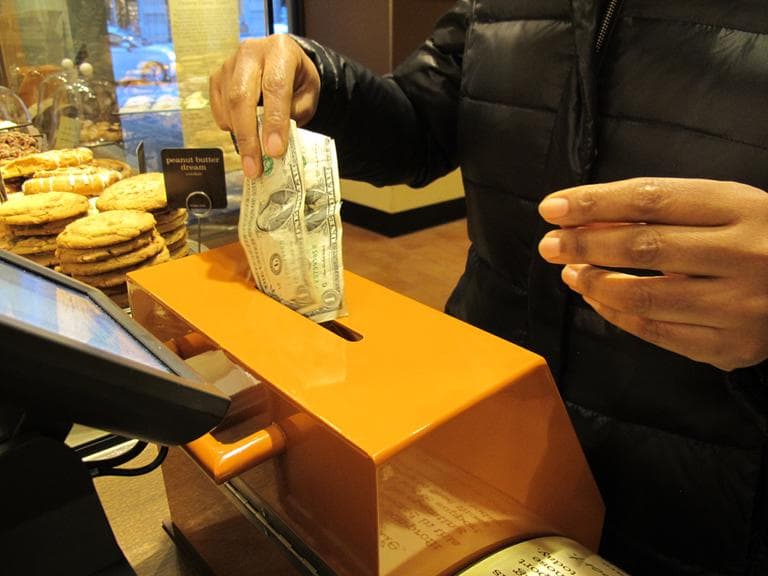Advertisement
Panera Cares Lets Customers Set The Price
ResumePanera Bread, the nationwide restaurant chain, has opened a new "pay-what-you-can" cafe in downtown Boston, called Panera Cares.
The concept is simple: diners pay what they can afford. So if a meal normally costs $5.00, the customer can pay that price, a little more, or a little less.
Store ambassadors greet customers when they come in to explain how things work, but it can be a little confusing.
"All they have is a responsibility to do the right thing. And you know what’s amazing? So many people do."
Ron Shaich
"I don't even know what's going on. I'm just hungry," a befuddled customer named Javier said.
Here's how it works: customers order their food, just like at a regular Panera, but then the cashier tells them the suggested price. Customers can decide how much to pay, and either put their money in a donation box, or tell the cashier how much to charge their credit card.
The Panera Bread Foundation has four other Panera Cares locations in St. Louis, Detroit, Portland, Oregon and Chicago, and the founder Ron Shaich says the system works because the people who can afford to pay more, often do.
"All they have is a responsibility to do the right thing. And you know what's amazing? So many people do," Shaich said.
The breakdown of what people pay is about 60-20-20: 60 percent of people pay the suggested price, 20 percent pay less, 20 percent pay more.

Since opening in January, the Panera Cares in Boston has been taking in slightly more than that national average.
Food Insecurity
Panera officials say the chain already donates about $100 million in food and cash a year. But Shaich wanted to become more involved in the issue of food insecurity - the 50 million Americans and one in four children who don't know where their next meal is coming from.
"This isn't an issue of simply of homelessness," Shaich said. "Twenty-five percent of people with food insecurity actually own their own homes, 24 percent are college grads. It's endemic when you have a country that is 8 to 9 percent unemployment."
It's a job requirement that all of the employees at the Boston Panera Cares location understand the issue.
"We've all experienced food insecurity one way or another, either personally or we know someone is experiencing it," said cashier Yetunde Bankole.
Panera Cares workers are also trained to deal with a population that is in need.
"We've all experienced food insecurity one way or another, either personally or we know someone is experiencing it."
Yetunde Bankole
"What they told us to do is just to smile at every customer, so even if they don't want to make eye contact with us, the fact that we're smiling is a sign that we're here and that we care. The smile is everything that will make their day," said Bankole.
Pay What You Can Cafe Movement
Denise Cerreta opened the first “pay what you can” cafe called One World Cafe in Salt Lake City, Utah in 2003.
And that's where Shaich got the idea for Panera Cares. He saw a television news story about a second cafe that Cerreta helped open in Denver called the So All May Eat (or S.A.M.E.) Cafe, and thought, "I can do that!"
"We studied the community cafe movement and generally they're small and they're in the back of churches, and I think so often what happens is that those in pain are separated out," Shaich said.
He wanted to offer a cafe where people who could afford to pay eat side-by-side with people who need a little help.
"We're not going to cure food insecurity with these cafes. We're not going to stop poverty. We're not going to stop hunger. What we are going to do is elevate the discussion around these issues," Shaich said.
This segment aired on March 26, 2013.